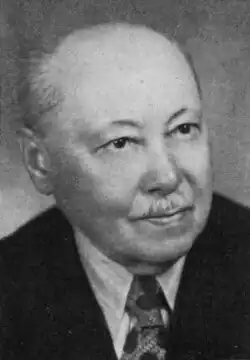Václav Melzer
Václav Melzer | |
|---|---|
 | |
| Born | 26 August 1878 |
| Died | May 1, 1968 (aged 89) |
| Nationality | Czech |
| Known for | Contributions to the taxonomy of Russula. Formulation of Melzer's reagent. |
| Children | 2 (died in early adulthood) |
| Scientific career | |
| Fields | Mycology |
| Author abbrev. (botany) | Melzer |
Václav Melzer (26 August 1878 – 1 May 1968) was a Czech teacher and mycologist. He was part of a group of Czech teachers who became mycologists at the beginning of the 20th century that also included figures such as Jindřich Kučera, Rudolf Veselý, and František Tyttl.[1] A substantial part of his life was spent living and working in Domažlice.
Life and career
Melzer was born on 26 August 1878 in Wilkischen Bohemia, Austria-Hungary (now Vlkýš, part of Heřmanova Huť in the Czech Republic. His scientific work was devoted mainly to Russula, in which he published the first Czech monograph of this basidiomycete genus. His discoveries in this genus included the Russula sardonia variety mellini, described in 1927,[2] and Russula helodes in 1929,[3] based on collections from the Soběslav area. The mycologist Josef Velenovský named the bolete species Boletus melzeri in his honor in 1922, which was initially collected by Melzer in 1920 at Čechtice.[4] Other taxa named after Melzer include the species Lentinus melzeri,[5] Russula melzeri,[6] and Russula lilacea var. melzeriana (now Russula melzeriana);[7] the genera Melzericium[8] and Melzerodontia[9] are also named in his honor.
He is well known in mycology for developing the staining solution Melzer's reagent, which he developed in 1924 as a modification of an older chloral hydrate-containing iodine solution developed by the botanist Arthur Meyer.[10] In Russula, the genus in which Melzer specialized, the amyloid reaction of the basidiospore ornamentation or entire spore is of great taxonomic significance.[11]
References
- ^ Kotlaba, František. (2008) ...A jak je vidí mykolog. In: J. Nesvadbová & S. Pecháčková. Historický atlas hub: Obrazy Františka Tyttla. [A Historical Atlas of Fungi: Pictures by František Tyttl.] Prague: Academia. ISBN 978-80-200-1578-5. p. 13.
- ^ Index Fungorum, accessed 2013-03-10.
- ^ Papoušek T, Beran M, and Vlasák J. (2010) Velký fotoatlas hub z jižních Čech (2nd edition). České Budějovice: Joseph Posekaný. p. 347.
- ^ Velenovský, Josef (1922). České Houby (in Czech). Vol. 1. Prague: České Botanické Společnosti. p. 186.
- ^ Velenovský, Josef (1922). České Houby (in Czech). Vol. 4–5. Prague: České Botanické Společnosti. p. 707.
- ^ Melzer, Václav; Zvára, Jaroslav (1927). "České holubinky. (Russulae Bohemiae)". Archiv pro přírodovědecký výzkum Čech (in Czech). 17 (4): 1-146 [83] – via HathiTrust.
- ^ Singer R. (1935). "Supplemente zu meiner Monographie der Gattung Russula". Annales Mycologici (in German). 33 (5–6): 318.
- ^ Hauerslev K. (1974). "New or rare resupinate fungi". Friesia. 10 (4–5): 315–22.
- ^ Hjortstam K, Ryvarden L. (1980). "Notes on Ceratocystis brunnea and Ophiostoma based on partial ribosomal DNA sequence data". Mycotaxon. 12 (1): 168–84.
- ^ Baral HO. (1987) Lugol's solution / IKI versus Melzer's reagent: Hemiamyloidity, a universal feature of the ascus wall. Mycotaxon 29: 399-450.
- ^ "Characteristics of the russuloid fungi". Russulales News. Museo Tridentino di Scienze Naturali. 2010-12-27 [2004-01-09]. Retrieved 2025-08-16.
- ^ International Plant Names Index. Melzer.
External links
- Život a dílo Václava Melzera (1878 — 1968) / Life and work of Václav Melzer (1878—1968) by Josef Herink & František Kotlaba, Česká Mykologie 23(1): 7-15, January 1969.